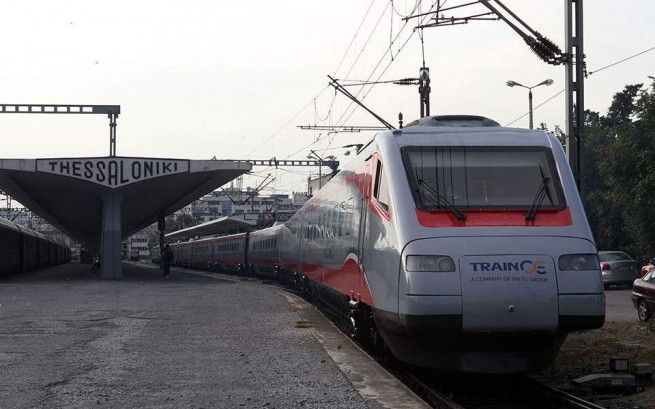Studying the situation leading to Tragedy in Tempiyou begin to understand that it was inevitable, since everything that was done in recent years on the railways of Greece led directly to this disaster.
In addition to problems with lack of automation and inevitable because of this, manual control of semaphores and arrows, as well as escorting trains along the Athens-Thessaloniki route in fact in manual mode, using a telephone or radio station, investigative journalists found that the trains themselves, which the Italian state-owned railway company Ferrovie dello Stato Italiane SpA, in 2016 bought out TrainOSE“attached” in Greece, were not just pretty used, but also very problematic …
In the title of the report Investigate Europepublished a year ago on February 18, 2022, said: “All I can say is good luck” – as trains decommissioned by Switzerland are sent to Greece.
For many years, the ETR 470 series trains have been the biggest headache for Swiss railways. As a result, the Swiss sent them for scrap. The Italian railways, which manages TRAINOSE, purchased decommissioned trains and presented them as “modern”. Twenty years ago, the Swiss press named the ETR 470 train on the Milan-Switzerland route “Pannenzug”, which means “emergency train”.
This is the same train that TRAINOSE brought to Greece in 2022, advertising it as “a new era of Greek railways.”
“Stay away from these trains,” said Swiss railway executives who knew firsthand about them. So why are these trains, which have repeatedly endangered passengers in the past, still allowed to run?
Contacted by Investigate Europe and Reporters United, two former officials familiar with the trains find it hard to believe that the five remaining ETR 470s not sent to landfill are now touted as the future of the Athens-Thessaloniki rail link, the most important route in the country.
“Advice from Switzerland: stay away from these trains” says Walter Finkboner, former board secretary of Cisalpino AG, a subsidiary of Italian and Swiss railways that bought an ETR 470 from Fiat Ferroviaria in the 1990s.
But Greece is in no position to accept such recommendations, nor to choose what will run its railways, since they were fully privatized five years ago, as demanded by its creditors.

A key feature of the ETR 470 is its tilt mechanism, which is how it got its name Pendolino, which means “little pendulum”. When entering a turn, the train is hydraulically raised from the outside and “lowered” on the inside, acquiring an 8-degree inclination, which allows it to reach higher speeds. The composition that was considered the future of railways 30 years ago!
Some experts argue that the reason the tilt technology didn’t catch on is because these trains were too complex and therefore not reliable enough.
Swiss Railways (SBB) was unable to fix the problems with the ETR 470 even after increasing funding and taking full control of their service.
Fires, damage, flight cancellations
The ETR 470 is the train that led the Swiss railway unions to require on an ongoing basis specially trained personnel, in addition to the driver, for trains entering tunnels over 1,000 meters long. This conclusion was drawn from an incident on April 11, 2006, when a Pendolino ETR 470 en route south from Stuttgart caught fire inside the Zimmerberg Tunnel.
Another fire broke out at ETR 470 in May 2011, just five minutes before entering the 15 km Gotthard Tunnel.
In 2012, an ETR 470 caught fire at Zurich Central Station. In the same year, the car turned into a “shaker” rocking its passengers for 10 minutes at Lucerne Central Station due to a faulty tipping system.
“ETR 470 electric locomotives must be immediately replaced by other rolling stock”, stated in a joint resolution of the Swiss unions of train drivers and railway workers in May 2011. They constantly cause huge traffic disruptions and cast a shadow on the image of the railways. They often don’t stick to the schedule, stop halfway through, or break down completely. All this creates a great burden on the staff, which is aggravated by constant and justified complaints from passengers.“.
Finally in 2014, when Swiss Railways shipped their own four ETR 470s to the Kaiseraugst train dismantling stationsaving the first class car for the railway museum, Trenitalia sent its remaining five trains to the softer Rome-Reggio Calabria route, and then, realizing the danger, sent … to Greece.
There, as on the Swiss line, the ETR-470 was supplemented by other, more advanced trains. There is no data on how many of the five were eligible to work at the same time. When asked by Investigate Europe, Ferrovie dello Stato spokesman Carlo Valentino replied that everything went well: “After an initial period of adaptation to the new engineering systems, the performance of the trains has always been very good, with absolute maintainability and reliability compared to the rest… of the train fleet“, – he said.
However, in reality, the ETR 470s differ from the rest of the Trenitalia fleet in that they have never been equipped with modern fire protection systems. By 2005, previous incidents convinced the Italian authorities to tighten fire safety regulations and require high pressure sprinkler systems on the roof of every car entering tunnels longer than 500 meters (UNI 11565 standard, revised in 2016). The regulation immediately applied to all new trains, and those already in operation had to either be modernized or withdrawn until the spring of 2020 (due to the pandemic, the deadline was slightly postponed). Instead of upgrading the ETR 470s to make them suitable for tunneling, FSI shipped them to Greece.
There are several tunnels on the Athens-Thessaloniki route that are over 500 meters long, and four (Kallidromou, Othris, Tempo and Platamonas tunnels) are over 2.5 kilometers long. Was the advanced active fire suppression system included in the overhaul of the ETR 470s after they left Italy and before they arrived in Greece? Investigate Europe requested a list of projects from Alstom Greece, but the latter did not respond, redirecting the questions to TRAINOSE, which provided no response.
abandoned line
Today in new ose (railway network) and TRAINOSE (operation and maintenance of trains) employs only 2,000 people. Many older workers have retired without being able to share their hard-earned experiences with the younger generation of railroad workers. This workforce struggles to meet the most pressing needs, as was painfully evident during the snowfall on January 24, when for the first time two long-distance trains were stuck in the snow for several hours on the country’s main and most modern line, between Athens and Thessaloniki..
And at the moment, Ferrovie dello Stato believes that there are no problems for the operation of the ETR 470: “As for the railway infrastructure, there are no special restrictions“, – said the representative of the Italian company Carlo Valentino.
So how did the ETR 470 perform on test runs on the Athens-Thessaloniki route?
Perhaps in order to simplify maintenance and prevent problems, TRAINOSE will disable the tipping mechanism, reducing the speed of the train, as the Polish Railways did with their Pendolino?
So why all this fuss around?fast trains“?
The Italian state company Ferrovie dello Stato Italiane (FSI) bought 100% TRAINOSE!!! for only 45 million euros, with a real value of 4 at least 870 million euros. The contract was immediately classified …
The contract to privatize the national railways remains classified, but people familiar with its terms, such as the current Deputy Minister of Infrastructure and Transport, Giorgos Karagiannis, call it “colonial.” This is an unusual statement from a member of the Conservative government. Moreover, the Greek Ministry of Transport agreed to subsidize the Italian company in the amount of 50 million euros per year to operate certain routes as described in the Public Service Commitment (PSO) contract. (It should be noted that the application for privatization of Russian Railwayswhich was ready to pay at least 20 times more, was categorically rejected).
Secret contracts
However, this contract remains secret despite freedom of information requests made by opposition MPs. Thus, passengers in Greece can only complain about the dissolution or disregard of subsidized routes, without being able to prove a breach of contract.
Last but not least, TRAINOSE secured an exemption until 2024 EU on the rights of passengers, which obliges railway companies to compensate passengers for accidents.
In practice, TRAINOSE sometimes offers compensation for delays and cancellations, but these payments are voluntary and the amounts are determined by the company.
TRAINOSE and its parent company respond to criticism by citing an imminent launch “new trains that will increase comfort, safety and speed on the Athens-Thessaloniki line“.







More Stories
What influenced Greece’s decision to help Kyiv with weapons?
The Minister of Health called the protesters "insignificant people, kafirs"
Gold Switzerland: “We are in the last 5 minutes of our financial system – the collapse of everything is approaching”